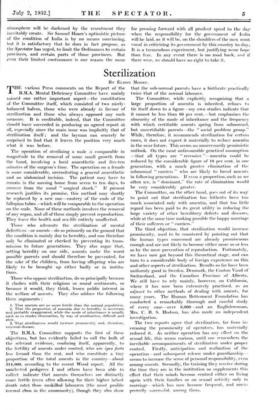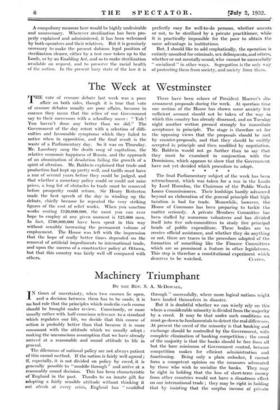Sterilization
Br ELDON MOORE. •
THE various Press comments on the Report of the B.M.A. Mental Deficiency Committee have mainly missed- one rather important aspect—the constitution of the Committee itself, which consisted of two nicely- balanced halves, those who were already in favour of sterilization and those who always opposed any such measure. It is creditable, indeed, that the Committee should have succeeded in producing an agreed report at all, especially since the main issue was implicitly that of sterilization itself ; and the layman can scarcely be surprised to find that it leaves the position very much what it was before.
The operation of sterilizing a male :s comparable in magnitude to the removal of some small growth from the hand, involving a locid anaesthetic and five-ten minutes of the surgeon's time. The operation on a female is more considerable, necessitating a general anaesthetic and an abdominal incision. The patient may have to remain in the nursing home from seven to ten days, to recover from the usual "surgical shock." If present research justifies its promise, this method may shortly be replaced by a new one—cautery of the ends of the fallopian tubes—which will be comparable to the operation on the male. None of these methods involves the removal of-any organ, and all of them simply prevent reproduction. They leave the health and sex-life entirely unaffected.
Those who advocate the sterilization of mental defectives—or aments—do so primarily on the ground that the condition is mainly due to heredity, and can therefore only be eliminated or checked by preventing its trans- mission to future generations. They also argue that, setting heredity on one side, ancients make the worst possible parents and should therefore be prevented, for the sake Of the children, from having offspring who are likely to be brought up either badly or in institu- tions.
Those who oppose sterilization, do so principally because it clashes with their religious or moral sentiments, or because it would, they think, lessen public interest in the welfare of aments. They also adduce the following three arguments 1.- That aments are no more fertile than the normal population.
2. That the proportion of amentia due to heredity is uncertain
and probably exaggerated, while the mode of inheritance is usually such as to render elimination, by way of sterilization, difficult and
slow.
3. That sterilization would increase promiscuity and, therefore, venereal disease.
The B.M.A. Committee supports the first of these objections,- but has evidently failed to call the bulk of the relevant evidence, confining itself, apparently, to the fertility of aments under control, who are ipso facto less fecund than the rest, and who constitute a tiny -proportion of the -total aments in the country—about 314;000, according to the recent Wood report.- All the 'unseleeted pedigrees I and others have --been able to collect indicate that aments. themSelves are distinctly more fertile (even after -allowing for their higher infant :death rate) than- unskilled- labourers (the -most prolific 'normal doss in the -community), though they- also show that the sub-normal parents have a birthrate practically twice that of the normal labourer.
• The Committee, while explicitly recognizing that a large proportion of amentia is inherited, refuses to tie itself clown to a figure—my own studies indicate that.
it cannot be less than 60 per cent.—but emphasizes the obscurity of the mode of inheritance and the frequency with which certifiable aments spring from subnormal, but uncertifiable parents—the "social problem group." While, therefore, it recommends sterilization for certain cases, it does not expect it materially to reduce anientia in the near future. This seems an unnecessarily pessimistic outlook. On the most unfavourable genetical assumption —that all types are "recessive "—amentia could be reduced by the considerable figure of 18 per cent, in one generation, with a much greater elimination of the subnormal " carriers " who are likely to breed aments in following generations. If even a proportion, such as we often see, is " dominant," the rate of elimination would be very considerably greater.
The Committee, on the other hand, goes out of its way to point out that sterilization has hitherto been too much associated only with amentia, and that too little regard has been paid to its great utility in reducing the large variety of other hereditary defects and diseases, while at the same time making possible the happy marriage of their sufferers or " carriers."
The third objection, that sterilization would increase promiscuity, used to be countered by pointing out that the human types concerned are already promiscuous enough and are not likely to become either more so or less so. by the mere prevention of reproduction. Fortunately, we have now got beyond this theoretical stage, and can turn to a considerable body of foreign experience on this and other aspects of sterilization. Results so far have been uniformly good in Sweden, Denmark, the Canton Vaud of Switzerland, and the Canadian Province of Alberta. We still have to rely mainly, however, on California, where_ it has now been extensively practised, as an adjunct to other methods of dealing with aments, for many years. The Human Betterment Foundation has conducted a remarkably thorough and careful study of every case—over 6,000—and an Englishwoman, Mrs. C. B. S. Hodson, has also made an independent investigation.
The two reports agree that sterilization, far from in- creasing the promiscuity of operatees, has materially reduced it. As neither operation has any effect on the sexual life, this seems curious, until one remembers the inevitable accompaniments of sterilization under proper control. Firstly, anticipation and realization of the operation—and subsequent release under guardianship— seems to increase the sense of personal responsibility, even among aments. Secondly, the training they receive during the time they are in the institution so supplements this effect that their 'minds become centred either on living again with their_ families or on sexual activity only in marriage— which has now become- frequent, and unex- pectedly - successful, among them. . A compulsory measure here would be highly undesirable and unnecessary. Wherever sterilization has been pro- perly explained and administered, it has been welcomed by both operatees and their relatives. But it is genuinely necessary to make the present dubious legal position of sterilization clearer, either by a test case taken up to the Lords, or by an Enabling Act, and so to make sterilization available on request, and to preserve the racial health of the nation. In the present hazy state of the law it is perfectly easy for well-to-do persons, whether aments or not, to be sterilized by a private practitioner, while - it is practically impossible for the poor to obtain the same advantage in institutions.
But, I should like to add emphatically, the operation is entirely. unsuited for criminals, sex delinquents, and others, whether or not mentally sound, who cannot be successfully, " socialized " in other ways. Segregation is the only way of protecting them from society, and society from them.







































 Previous page
Previous page